The role of the State in remembrance policy
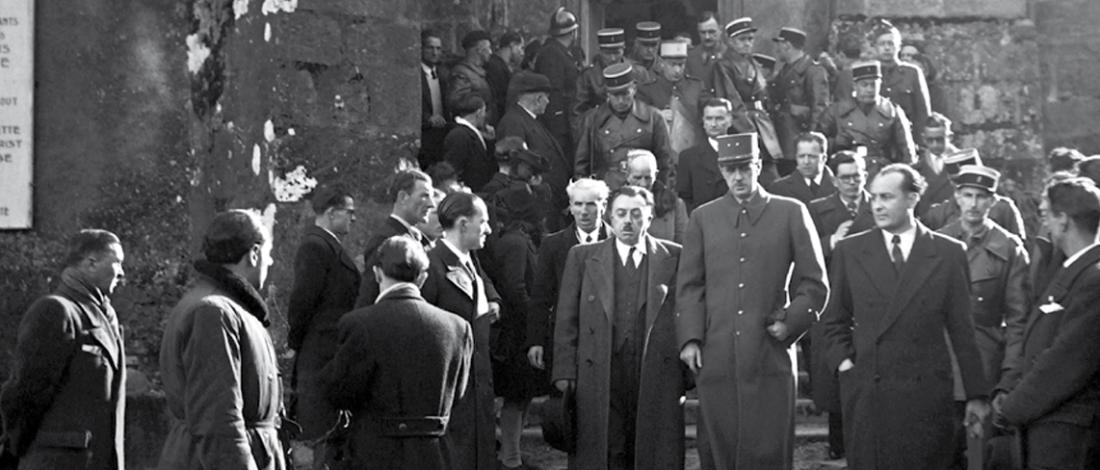
Despite the considerable convergence of experiences of contemporary conflicts in France and Germany, the introduction of remembrance policies in the two countries has been deeply asymmetrical, given their political systems – one a centralised State, the other a federal State.
The concept of the State is ambiguous. In this instance, it makes sense to use a definition derived from political science, according to which the State is a system of public institutions whose aim is to regulate the affairs of a community, from its summit right down to the smallest village. In a centralised state like France, authority is exerted over the whole country from Paris, whereas in a federation like the Federal Republic of Germany, Länder are given more power, resources and autonomy than the French regions, despite the growing shift towards decentralisation.
Because the Länder insisted on having sovereignty over culture and education, the Constitution of the Federal Republic of Germany, proclaimed in 1949, made these two areas – as was already the case under the Weimar Republic – the “heart of the state identity of the federated states” (Article 30 and Article 70(1)). That has had important consequences for remembrance policy right up to the present day.
Presidential power regarding remembrance policy
On 4 March 1945, Charles de Gaulle visited Oradour-sur-Glane, a village reduced to ashes by the Germans, and declared it a symbol of what had happened to France as a whole, in an appeal to the French people for national unity.
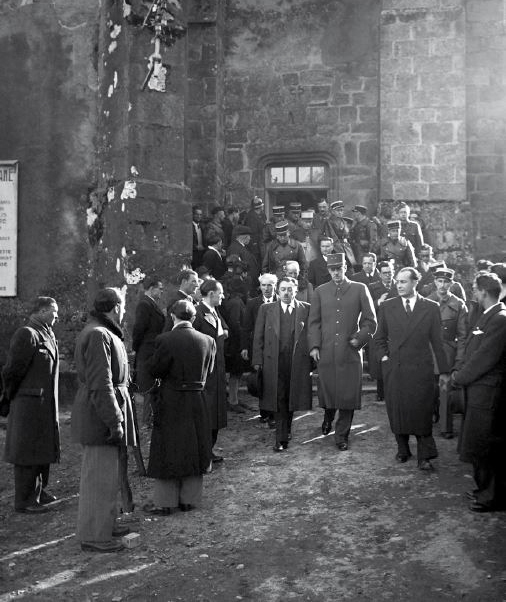
General de Gaulle, head of the provisional government, visits the martyr village of Oradour-sur-Glane, 4 March 1945. © AFP
DTen years after the execution of the organisers of the assassination attempt of 20 July 1944 against Hitler, the German president, Theodor Heuss, refuted the widely held belief that Stauffenberg and his co-conspirators had betrayed their country, thus gradually paving the way for a new interpretation of resistance by the army. A few years later, President Richard von Weizsäcker used the 40th anniversary of the end of the war as an opportunity to interpret 8 May 1945 not only as a day of liberation from national socialism, but also as a moment of liberation for the German people. Another example, on the French side, was 16 July 1995, when Jacques Chirac acknowledged for the first time France’s responsibility in the deportation to Germany of Jews living on French soil. These remembrance speeches emphasise the considerable symbolic power held by the two presidents.
In spite of all they have in common, there are marked differences between the political structures and traditions of France and Germany, in particular the far greater political power wielded by the French president compared to the representative role of his German counterpart. Thus, on 5 April 2019, President Emmanuel Macron set up a commission to investigate the French archives on Rwanda and the Tutsi genocide (1990-94), aimed at shedding light on France’s role in that genocide. Then, in July 2020, ahead of the 60th anniversary of Algerian independence, he commissioned historian Benjamin Stora to analyse the way in which France treats its colonial past and the Algerian War. Stora published his findings on 20 January 2021, in a report entitled “Remembrance issues concerning colonisation and the Algerian War”. These two examples are the expression of a presidential system of government, whereas similar initiatives in Germany fall within the remit of the federal parliament.
The role of the parliament in remembrance policy
The responsibility of the Bundestag with regard to remembrance policy arose a short time after reunification, when it established two commissions of inquiry into the history and remembrance of the German Democratic Republic (GDR): the “Commission of Inquiry for the Assessment of History and Consequences of the SED (East German Socialist Unity Party) Dictatorship in Germany”, in 1994; and the “Commission of Inquiry on Overcoming the Consequences of the SED Dictatorship in the Process of German Unity”, in 1998. In their final report of 1998, the commission members recommended that the Federal Republic should commit more strongly to “forms of remembrance common to all Germans, in respect of the two German dictatorships and their victims”.
The first consequence of this change involved the restructuring of remembrance policy at federal level. Thus, under Chancellor Gerhard Schröder’s administration, the role of “Federal Government Commissioner for Culture and the Media” was transformed into that of “Minister of State for Culture and the Media”, combining the activities of a number of ministries and, importantly, coming under the control of the federal parliament. The post-holder is a Minister of State to the Chancellor, but is not a member of the Federal Government, since cultural policy is primarily decided by the Länder.
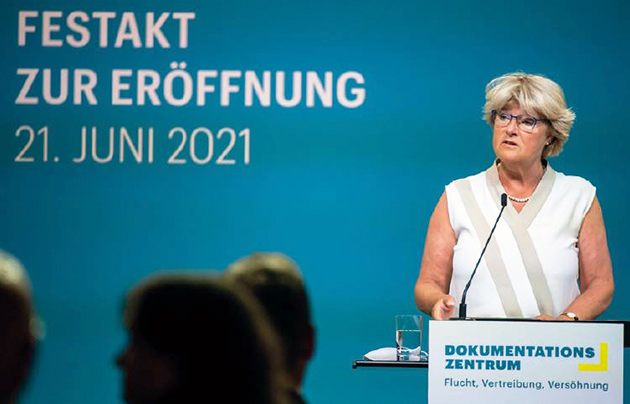
Monika Grütters, Minister of State for Culture and the Media, at the opening of the Foundation for Displacement, Expulsion and Reconciliation, Berlin, 21 June 2021.
© Bernd von Jutrczenka/DPA/dpa Picture-Alliance via AFP
A second consequence of the change was the adoption of a resolution by the Bundestag in 1999 to promote remembrance sites, in particular those in memory of the “victims of the war and the National Socialist dictatorship” and “victims of the communist dictatorship in the Soviet Occupation Zone and the GDR”. The construction of remembrance sites went on to see regular developments, with the Federal Parliament deciding in 2007 to erect a “Monument to Freedom and Unity” in Berlin. After lengthy controversy, work got underway in 2020 and it is due to be unveiled in spring 2022.
In another example, in spring 2008, parliamentarians voted to establish the Foundation for Displacement, Expulsion and Reconciliation, whose main purpose was the setting up of a documentation centre on displacements, expulsions and forced migrations, past and present. The history of this initiative was similarly marked by virulent debates between revisionists and those who believed the centre should be a place of reconciliation. This new site was eventually opened in Berlin in June 2021 by Angela Merkel.
Since 2008, other remembrance sites have been designed with a desire for Germany to acknowledge its responsibility and promote sites of national importance that preserve the memory of the Nazi regime of terror and its victims, and to develop remembrance around the dictatorship in the former GDR. Among these sites are the Memorial to the Murdered Jews of Europe (Berlin), the Topography of Terror museum (Berlin) and the House of the Wannsee Conference (Berlin). The sites concerning the Soviet Occupation Zone/GDR include the Berlin-Hohenschönhausen Memorial (former prison of the GDR’s Ministry of State Security, the Stasi), the Berlin Wall Foundation (Berlin) and the Point Alpha Memorial, on the former inner German border (Marienborn).
In comparison, France’s National Assembly plays a far more modest role with regard to remembrance, though that has not prevented it from getting involved in the area since the early 1990s, as part of its traditional legislative function. For instance, in response to antisemitism and xenophobia, the Gayssot Act (1990) made it a crime to deny the Holocaust and crimes against humanity. The Taubira Act (2001) acknowledged the slave trade and slavery as crimes against humanity. However, the problematic nature of these remembrance laws came to the fore during the voting of the law on the Armenian genocide (2001), whereby France officially acknowledged the genocidal nature of the mass murder perpetrated against the Armenian people, and the law to suppress challenges to the existence of genocides recognised by law (2011). In this instance, the question was raised as to whether these laws were constitutional, and whether it was the role of Parliament to write history and direct remembrance actions. That debate was revived once more in 2005, when conservative deputies voted a law requiring school textbooks to emphasise the positive role of the French presence overseas; the article in question was ultimately removed.
The ministries’ executive power
The French example highlights the dominant role played by the ministries in funding and developing remembrance. For instance, the French Ministry of the Armed Forces organises 11 national days each year, as well as national tributes and commemorative ceremonies linked to the current remembrance cycle. In addition, it maintains and promotes 275 national cemeteries and 10 key national remembrance sites, and oversees remembrance tourism development policy, through the signing of partnership agreements with the regions and by coordinating a network of nearly 150 remembrance sites. Another example in the executive sphere is the Ministry of Culture, which supports over 1200 museums across France. Since 2002, it has awarded the “Musée de France” label, proof of its desire to support, in words and in deeds, museums like the Mémorial de Caen, the Musée de la Guerre de 1870 et de l’Annexion (Gravelotte) and the Historial de la Grande Guerre (Péronne), while at the same time requiring compliance with certain scientific and technical criteria. This process can be viewed as the expression of a centralised management of the museum landscape.
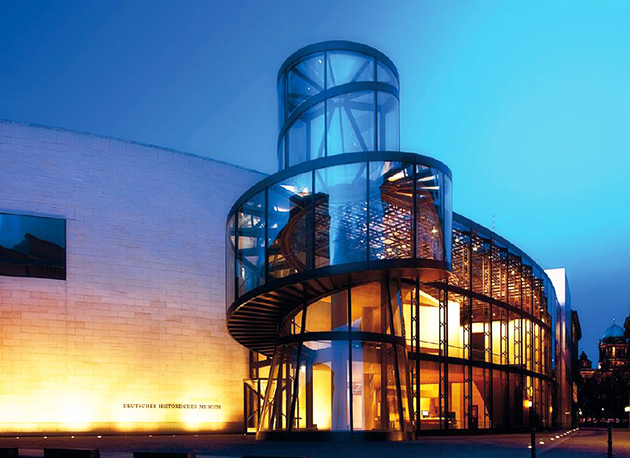
The Deutsches Historisches Museum, 17 March 2009. © Andreas Levers
In Germany, the process is decentralised. For instance, the Deutsches Museum in Munich is a public-law entity under the protection and supervision of the Bavarian regional government, despite receiving funding from the Federation and from other federated states. On 30 December 2008, the Deutsches Historisches Museum became a public-law foundation directly attached to the Land, whose board of directors is made up of representatives of the Federation, the Federal Parliament and federated states.
But those wishing to keep memories alive for future generations should look not only to museums but to archives too. The organisation of public archives reflects, on the one hand, the history of a national State and, on the other, its structures and remembrance culture.
The history of the French National Archives – where the archives of the central bodies of the State, except for the Armed Forces, Finance and Foreign Affairs ministries, are kept – dates back to 1789-90. They have been subordinate to the Ministry of Cultural Affairs since 1959, when the latter was created. In Germany, the Reich Archives were not established until 1919, and had the purpose of collecting and cataloguing the documents of the German Empire, 1871-1918. At the end of the Third Reich, five years elapsed before the creation of the Federal Archives, in 1950, located in Koblenz since 1952. Today, they are the responsibility of the Ministry of State, and have other sites in Berlin, Freiburg im Breisgau, Bayreuth and Ludwigsburg. The Federal Archives hold the documentary archives of the Federation, the GDR’s central authorities, the occupation zones and the German Empire and its predecessors.
In June 2021, the Federal Archives also took over responsibility for the documentary archive of the former GDR’s Ministry of State Security. The rules permitting public bodies, historians and victims to consult the documents remain unchanged, which means that the former inhabitants of the GDR can see the level of control which the Stasi exerted on their private lives. The powers of the Ministry of State also extend to other archives and institutions concerned with historical research and information, for example the Arolsen Archives – International Center on Nazi Persecution, which helps shed light on the personal fates of the victims of Nazism. Access to the archives is a sensitive issue in France and Germany, and regularly sparks discussions between State representatives and historians.
In both countries, preserving memory ultimately involves working with schools. East of the Rhine, where education is the responsibility of the Länder, there is no national remembrance agenda for schools. Although the Federal Government takes the reins of initiatives concerned with historical remembrance (2020 was devoted to the “30th anniversary of German reunification”), the Länder continue to retain control over the inclusion of remembrance in the school curriculum. For instance, on 30 May 2018, the education ministers of Rhineland-Palatinate and Saarland teamed up with the Yad Vashem memorial on an initiative to expand the remembrance work done in schools. In 2020, the state of Brandenburg put the focus of its school curriculum on the importance of the iconic remembrance sites from the Nazi era, the end of the SED dictatorship and German reunification.
In France, school students are closely associated and involved in the remembrance work carried out by the Ministry of the Armed Forces. They are encouraged to join in the national ceremonies and to take part in calls for projects on remembrance themes. Still at national level, the Ministry of National Education, Youth and Sports contributes to the implementation of remembrance policy and administers defence education, working closely with institutional partners like the Ministry of the Armed Forces Directorate for Heritage, Remembrance and Archives (DPMA) and its remembrance operator, the National Office for Veterans and Victims of War (ONAC-VG), as well as remembrance foundations, museums and remembrance sites. Defence education is a compulsory subject, unlike anywhere else in Europe. It began to be taught in 1997, with the end of national service, and shows how France has a different relationship with combatant remembrance than Germany.
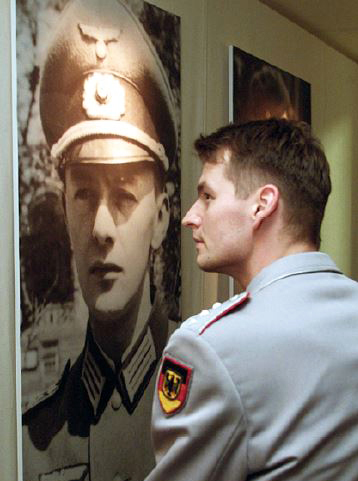
A German serviceman visits the exhibition on crimes of the Wehrmacht shown in November 2001 at the Deutsches Historisches Museum, Berlin.
© Wolfgang Kumm/dpa_pool/dpa Picture-Alliance via AFP
In the sphere of remembrance education, the German Ministry of Defence has opted for a more discreet approach, preferring to focus on “learning lessons from our failings and our duties”. German discussions around combatant remembrance involve a critical confrontation with the role of the army at the time of the “Third Reich”. This process means acknowledging the crimes of the Wehrmacht in the Second World War, and also spotlighting model soldiers like Colonel Claus Graf Schenk von Stauffenberg, who organised the army’s resistance against the Nazi regime. This was of particular relevance recently, when some soldiers of the Bundeswehr displayed neo-Nazi ideas. The difficulty which military remembrance poses for German society came once again to the fore in 2009, with the controversy over the erection, on land belonging to the Ministry of Defence, of a Bundeswehr memorial to the more than 3 300 men and women who have lost their lives in the line of duty.
Länder versus régions
The Bund and Länder are keen to work more closely together today, although the Länder are quick to defend their own prerogatives in the remembrance sphere. The Federation mainly gets involved where remembrance initiatives have national scope, for instance the upkeep of commemorative monuments. Since 1950, through its “Cultural monuments of national importance” programme, the Federation has funded the conservation of historic monuments, archaeological sites, and historic parks and gardens. Between 1950 and 2020, the programme provided grants to the value of € 387 million for the upkeep and restoration of over 700 cultural monuments. Since 2007, specific programmes have also been in place to fund small-scale initiatives that contribute to protecting and preserving monuments. Between 2007 and 2021, nearly 2 100 monuments of cultural importance were cleaned up, at a cost of € 330 million. What is characteristic here is co-financing, as the Länder, municipalities, owners and project developers must all have equal participation. The aim of these programmes is also to support small and medium-sized enterprises and traditional construction-related crafts.
Cultural federalism comes into its own wherever Länder are unable to fund a remembrance initiative using their own resources and need help from the Federation. Each of Germany’s 16 states has its own way of working. For example, in the Land of Baden-Württemberg, work on remembrance sites has mostly been down to the involvement of civil society. With the goal of supporting themselves and defending their own interests vis-à-vis politicians and the general public, remembrance sites, founded by private initiative, joined forces in 1995 within the Landesarbeitsgemeinschaft der Gedenkstätten und Gedenkstätteninitiativen (LAGG), the state working group on remembrance sites and remembrance-site initiatives, which cooperates closely with the Landeszentrale für politische Bildung (LpB), the regional centre for civic education. The regional parliament entrusted the LpB with the task of making the Land’s remembrance sites better known, by coordinating their promotion. The LpB also awards grants and offers advice to remembrance sites on their programming. The partnership sealed on 14 July 2020 between Baden-Württemberg and France has also given the German state the opportunity to support cross-border remembrance initiatives.
In Saxony, too, work around remembrance sites got underway after 1990, on the initiative of civil society. Since remembrance policy in the GDR had been confined to honouring the communist victims of Nazism, the task was to give a plural meaning to the notion of victims, by giving their dignity back to victims of the Third Reich and the SED dictatorship.
Therefore, on 15 February 1994, the state of Saxony established the Saxon Remembrance Foundation in memory of the victims of dictatorships and, with the law of 28 February 2003, laid the foundations of legislation to preserve historic sites associated with crimes committed under the two totalitarian regimes. However, there followed a rise in “competitive victimisation” and a debate as to whether the two regimes should be put on an equal footing, since this tended to relativise the Nazi war crimes. A new law came to relieve the situation, which has been in effect since 16 December 2012. The cases of Saxony and Baden-Württemberg show how, using their considerable resources, the Länder have been able to develop a structured remembrance that takes into account regional characteristics.
The French regions, too, have gained more responsibility and autonomy with decentralisation. For the remembrance cycles, they put on commemorative programmes to showcase the unique aspects of their history and remembrance, albeit often in cooperation with the central government in Paris. The Grand Est region, for example, regularly funds projects concerned with the history of the border area between France and Germany and the fate of the “Malgré-Nous” (Frenchmen from Alsace-Lorraine who were conscripted into the German army). The Languedoc-Roussillon region funds the Rivesaltes Camp Memorial in partnership with the department of Pyrénées-Orientales. The Auvergne-Rhône-Alpes region supports the remembrance work of Maison d’Izieu. There are many more examples, for the regions have grasped the tourism potential of regional remembrance sites. That said, engaging in this sphere of activity does not exclude the regions from receiving help and support from central government in many of these regional initiatives.
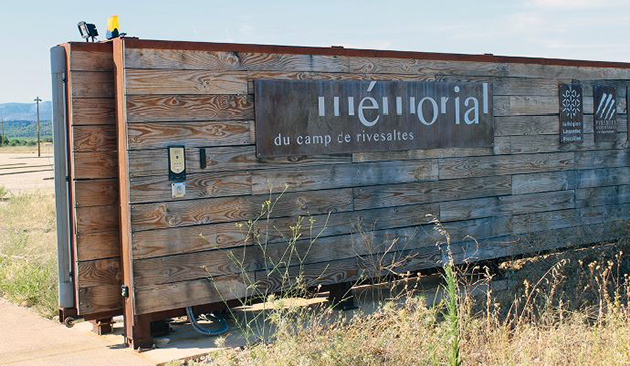
Rivesaltes Camp Memorial, 17 July 2016. © Maxime Soens
In the case of France, the different public bodies have the opportunity to participate far more directly in remembrance initiatives, whereas in Germany, the experience of two totalitarian regimes in the 20th century has led to decentralised remembrance, aimed precisely at limiting the power the State has over it. In spite of all these structural differences, remembrance initiatives in both France and Germany involve public bodies, civil society and the academic community.
A look at what is done across Europe shows how productive, plural remembrance is still possible when the State respects the principle of subsidiarity and does not let political or ideological concerns get in the way of such important historical and remembrance issues. Therefore, it is desirable for the State to offer a forum for discussion that makes for a remembrance which is open to criticism and controversy.

